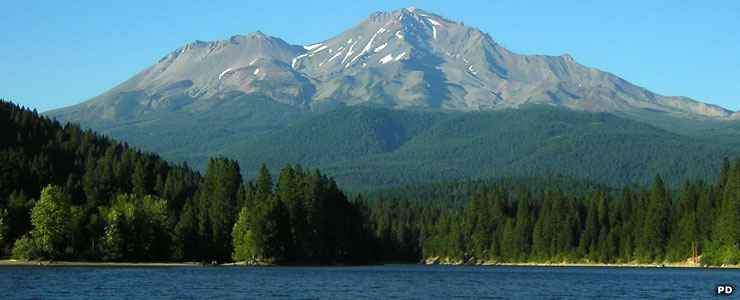Mount Shasta Wilderness

Mount Shasta, centerpiece of the Mount Shasta Wilderness
Mount Shasta Wilderness is a 34,005-acre property on Shasta-Trinity National Forest that surrounds and includes the Mount Shasta volcano complex. At 14,162 feet in elevation, it is one of the two 14,000+ foot peaks in California that is not part of the Sierra Nevada Mountains (the other being White Mountain in White Mountains Wilderness).
On the north slopes of Mount Shasta is the Wintun Glacier: although it extends up the hill to the summit, with the bottom at 9,100 feet it's the lowest elevation glacier in California. In all, there are seven glaciers extending downward from Shasta's summit. About one mile west of the Mount Shasta summit is the summit of Shastina, a volcanic cone that formed over the years since the last Ice Age.
Mount Shasta Wilderness protects forest filled with old growth and areas of forest that were heavily logged (and roaded) before the property was protected in 1984. Less than half the mountain is roadless now but all those old roads make for good hiking trails... Most of the wilderness is on the upper slopes of the volcano.
The forested areas are covered with a mix of Douglas and white fir, sugar pine and incense cedar with western white pine showing in the higher elevations. The lava flows on the northeast flank support aspen, juniper and mountain mahogany while underbrush in most areas consists of greenleaf and pinemat manzanita, chinquapin, tanoak and snowbrush. Among the larger mammals on the property are black bear, blacktail deer and coyote. There are also enough smaller mammals to support a healthy population of eagles, hawks, prairie falcons and other raptors.
Mount Shasta is large enough that it makes its own weather patterns. Above treeline (essentially 8,000 feet), falling rocks are a major danger. The best time to climb the mountain is June and July while the slopes still have some snow on them. There is no single designated trail to the summit but several cross-country routes go there, all require experience in traversing snow and ice. That means having prior experience with and carrying on your back an ice ax and crampons.
A parking permit is required, a free wilderness permit is required and if hiking above 10,000 feet, you need to purchase a Summit Pass for each climber.